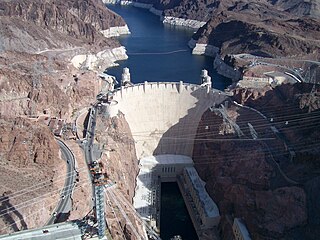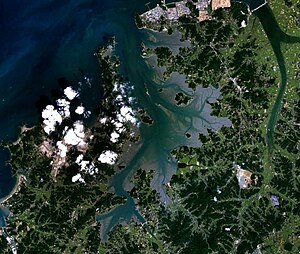
Tidal power or tidal energy is harnessed by converting energy from tides into useful forms of power, mainly electricity using various methods.

Naju is a city in South Jeolla Province, South Korea.

Electric power systems consist of generation plants of different energy sources, transmission networks, and distribution lines. Each of these components can have environmental impacts at multiple stages of their development and use including in their construction, during the generation of electricity, and in their decommissioning and disposal. These impacts can be split into operational impacts and construction impacts. All forms of electricity generation have some form of environmental impact, but coal-fired power is the dirtiest. This page is organized by energy source and includes impacts such as water usage, emissions, local pollution, and wildlife displacement.
Korea Hydro & Nuclear Power is a subsidiary of the Korea Electric Power Corporation (KEPCO). It operates large nuclear and hydroelectric plants in South Korea, which are responsible for about 27 percent of the country's electric power.
Korea Electric Power Corporation, better known as KEPCO or Hanjeon, is the largest electric utility in South Korea, responsible for the generation, transmission and distribution of electricity and the development of electric power projects including those in nuclear power, wind power and coal. KEPCO, through its subsidiaries, is responsible for 93% of Korea's electricity generation as of 2011. The South Korean government owns a 51.11% share of KEPCO. Together with its affiliates and subsidiaries, KEPCO has an installed capacity of 65,383 MW. On the 2011 Fortune Global 500 ranking of the world's largest companies, KEPCO was ranked 271. KEPCO is a member of the World Energy Council, the World Nuclear Association and the World Association of Nuclear Operators. As of August 2011, KEPCO possesses an A+ credit rating with Fitch Ratings, while Moody's has assigned KEPCO an A1 stable rating.

The production of renewable energy in Scotland is a topic that came to the fore in technical, economic, and political terms during the opening years of the 21st century. The natural resource base for renewable energy is high by European, and even global standards, with the most important potential sources being wind, wave, and tide. Renewables generate almost all of Scotland's electricity, mostly from the country's wind power.

South Korea is a major energy importer, importing nearly all of its oil needs and ranking as the second-largest importer of liquefied natural gas in the world. Electricity generation in the country mainly comes from conventional thermal power, which accounts for more than two thirds of production, and from nuclear power.

Sihwa Lake Tidal Power Station is the world's largest tidal power installation, with a total power output capacity of 254 MW. When completed in 2011, it surpassed the 240 MW Rance Tidal Power Station, which was the world's largest for 45 years. It is operated by the Korea Water Resources Corporation.

Hydroelectricity is, as of 2019, the second-largest renewable source of energy in both generation and nominal capacity in the United States. In 2021, hydroelectric power produced 31.5% of the total renewable electricity, and 6.3% of the total U.S. electricity.
KEPCO Nuclear Fuel (KEPCO NF) is a South Korean public enterprise established in 1982. It provides nuclear fuels to 24 nuclear power plants in South Korea. The price of the nuclear fuel provided by the company accounts for 60% of the average international price.

A tidal stream generator, often referred to as a tidal energy converter (TEC), is a machine that extracts energy from moving masses of water, in particular tides, although the term is often used in reference to machines designed to extract energy from run of river or tidal estuarine sites. Certain types of these machines function very much like underwater wind turbines, and are thus often referred to as tidal turbines. They were first conceived in the 1970s during the oil crisis.

Pakistan–South Korea relations refers to bilateral diplomatic relationship between Pakistan and South Korea. Since the 1980s, the relations between the two Asian states have improved and periodically enhanced. Pakistan has an embassy in Seoul, South Korea, and South Korea has an embassy in Islamabad, Pakistan. Pakistan is one of the few countries that has good relations with both North Korea and South Korea.
Renewable energy in Russia mainly consists of hydroelectric energy. Russia is rich not only in oil, gas and coal, but also in wind, hydro, geothermal, biomass and solar energy – the resources of renewable energy. Practically all regions have at least one or two forms of renewable energy that are commercially exploitable, while some regions are rich in all forms of renewable energy resources. However, fossil fuels dominate Russia’s current energy mix, while its abundant and diverse renewable energy resources play little role.

The Alamosa Solar Generating Plant is a 35.3 MWp (30.0 MWAC) concentrator photovoltaics (CPV) power station, the largest in the world when it was completed, in May 2012. It is currently the world's third largest operating CPV facility. The output is being sold to Public Service of Colorado, a subsidiary of Xcel Energy, under a long term Power Purchase Agreement.
Moorside nuclear power station is proposed for a site near Sellafield, in Cumbria, England. The original plan by NuGeneration, a British subsidiary of Toshiba-owned Westinghouse Electric Company, had the station coming online from 2024 with 3.4 GW of new nuclear capacity, from three AP1000 reactors. Work up to 2018 would include acquiring the site licence, the development consent order, and other required permits and permissions to start work. Site preparation was to take two years, up to 2020.
Tidal Lagoon Swansea Bay was a proposed tidal lagoon power plant that was to be constructed in Swansea Bay off the south coast of Wales, United Kingdom. Development consent was granted by the UK government in June 2015, and in June 2018 the Welsh Government approved the plan and offered to invest £200 million; however, later that month the UK government withdrew its support on value-for-money grounds. Other options to enable the proposal to go ahead were reportedly still being explored.
Wind power is a form of renewable energy in South Korea with the goal of reducing greenhouse gas (GHG) and particulate matter (PM) emissions caused by coal based power. After two oil crises dating back to the 1970s, the South Korean government needed to transition to renewable energy, which encouraged their first renewable energy law in 1987.

The Mersey Barrage is a proposed scheme for building a tidal barrage across the Mersey Estuary. In December 2022, the Liverpool City Region mayor announced cooperation between the City Region and K-water of South Korea, who built and operates the Sihwa Lake Tidal Power Station, in order to construct a similar operation on the River Mersey.











